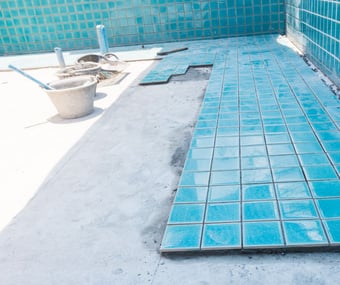When it comes to building or renovating homes, render and screed are often at the forefront of people's minds. However, it is important to recognise that both render and screed are also crucial elements in the construction of swimming pools. Rendering a pool is a completely different process than rendering walls due to the added pressure from water on the surfaces and finishes. This means that careful consideration must be given to the materials and application methods used. Here are some tips to help you with the rendering and screeding of your pool.

Once the initial concrete pool shell has been sprayed or shuttered into place, the next step is to apply render and screed before adding the final decorative finish of tiles, mosaic, or terrazzo. The pool walls can be rendered, while the floor can be rendered, self-levelled, or screeded. This stage is crucial as it creates an even and smooth surface that is essential for achieving the desired final finish. Given the unique requirements of pool construction, it is recommended to use a specialist polymer enhanced screed/render. Alternatively, a pre-mixed waterproofing solution can be combined with render to ensure optimal results.

When applying render to opposite sides of the pool, it is important to ensure that they are parallel and plumb. This requires careful preparation when installing the render system to ensure that all surfaces are completely flat. Any unevenness can be visible, especially when underwater lights are turned on. Some tradesmen have found that placing a run of battens along the top and bottom edge of the pool is helpful in achieving a perfectly smooth and flat render. These battens allow the applicator to easily run a rule/derby/I-bar across the render, resulting in a flawless finish. Once the render has completely cured, the battens can be removed and any gaps can be filled to match the level of the cured render.
In recent years, liquid flow screed has gained popularity as an alternative to traditional sand and cement. This pre-mixed screed is quick to pour and dries faster, making it a convenient choice for pool construction. Screeding the pool floor is an excellent way to create a level base for the final finish. Depending on the specific product you are using, the screed can be laid at depths as little as 25mm. However, it is important to always refer to the product specifications to ensure that you avoid any potential cracking issues.
In conclusion, render and screed are essential components in both home construction and pool building. Understanding the differences and requirements for rendering and screeding pools is crucial for achieving a successful and visually appealing final result. By carefully selecting the appropriate materials and applying them with precision, you can ensure that your pool is not only functional but also aesthetically pleasing. So, whether you are building a new pool or renovating an existing one, make sure to keep these tips in mind for a successful rendering and screeding process.
Additionally, it is worth mentioning that proper maintenance is crucial to ensure the longevity and durability of your pool's render and screed. Regular inspections and repairs, if necessary, should be carried out to address any cracks, chips, or other signs of wear and tear. It is also important to use the correct cleaning and maintenance products to avoid damaging the render or screed surface. By taking these steps, you can enjoy a beautiful and well-maintained pool for years to come.
